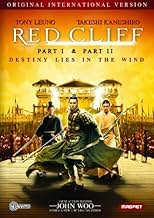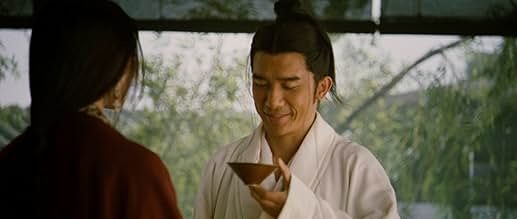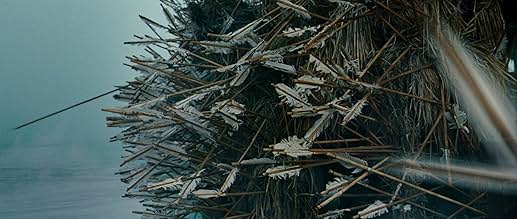VALUTAZIONE IMDb
7,5/10
26.078
LA TUA VALUTAZIONE
Aggiungi una trama nella tua linguaSecond and final part of epic tale about a legendary battle that changed the course of China history.Second and final part of epic tale about a legendary battle that changed the course of China history.Second and final part of epic tale about a legendary battle that changed the course of China history.
- Regia
- Sceneggiatura
- Star
- Premi
- 8 vittorie e 20 candidature totali
Tony Leung Chiu-wai
- Zhou Yu
- (as Tony Chiu Wai Leung)
Nicole Dionne
- Xiao Qiao
- (voce)
Recensioni in evidenza
I first saw the 148 mins version in 2009 on a dvd which I own.
Saw the 288 minutes version few days back.
I liked the 148 mins version but i liked the 288 mins version even more n inspite of the runtime, i never felt like fiddling with my phone. In fact, i found the film very captivating.
The film has tons of action. A true old school war with tons of bows n arrows, spears, swords, horses, ships, etc.
Apart from the battlefield action sequences, all the characters are awesomely developed, the cinematography is lovely n some of the scenes are picturesque.
There is absolutely no shaky cam or fast cut editing. One can easily make out what is going on during the war scenes. None of the scenes is shot in too much darkness.
We have a daring character Gan Ning (Nakamura Shido II) who does a stint like Steve McQueen's character from Hell is for Heroes. I love both the scenes.
The hand chopping scene, the sword slashings n the spears piercing, are all brutal.
After finishing the film, rice flour and sugar stayed on my mind. I tried the recipe on YouTube.
Some drawbacks - The initial scene with the baby on the back n running n fighting is lol n far fetched.
John Woo had already done this mistake in Hard Boiled with the baby peeing n all.
Another far fetched n lol scene in this movie is that of catching a woman in midair.
Saw the 288 minutes version few days back.
I liked the 148 mins version but i liked the 288 mins version even more n inspite of the runtime, i never felt like fiddling with my phone. In fact, i found the film very captivating.
The film has tons of action. A true old school war with tons of bows n arrows, spears, swords, horses, ships, etc.
Apart from the battlefield action sequences, all the characters are awesomely developed, the cinematography is lovely n some of the scenes are picturesque.
There is absolutely no shaky cam or fast cut editing. One can easily make out what is going on during the war scenes. None of the scenes is shot in too much darkness.
We have a daring character Gan Ning (Nakamura Shido II) who does a stint like Steve McQueen's character from Hell is for Heroes. I love both the scenes.
The hand chopping scene, the sword slashings n the spears piercing, are all brutal.
After finishing the film, rice flour and sugar stayed on my mind. I tried the recipe on YouTube.
Some drawbacks - The initial scene with the baby on the back n running n fighting is lol n far fetched.
John Woo had already done this mistake in Hard Boiled with the baby peeing n all.
Another far fetched n lol scene in this movie is that of catching a woman in midair.
If the first part of the series was the set up, here is the pay off. I was disappointed at the end of the first part when big To Be Continued words filled the screen. But it was worth the wait. When it comes to Chinese epics, it gets no better than this. Mostly an incredibly long, epic battle, this second part pays off in spades. It's more exciting, smarter, and more edge of your seat. Every minute leaves you anticipating the next and the conclusion is very fitting. You almost don't want it to end, despite the huge running time. John Woo has succeeded in creating one of the grandest Asian epics ever made, and this series of films should cement him as one of the finest Asian filmmakers of all time.
With the cast established, their motivations solidified, the stage set and the first volleys already thrown in the original, John Woo is able to just sit back, relax, and make the thoroughly indulgent epic action picture he always wanted in its sequel. Where the first film thematically leans more in the direction of theology and politics, backed by a brief taste of large-scale military maneuvers, this follow-up is a full-gale blast of battlefield planning and dramatic execution. History buffs may grimace at a few of its flashier moments, like the warrior who uses his spear to pole vault over enemy battalions, but those are rare enough to write off as passing fits of eccentricity from a director who's not always known for his realism. Besides, the real sizzle lies with the world-class, hour long battle scene that closes the picture - and the obscene amount of fascinating war maneuvers seen therein. It's the mother of all fight scenes, an intense, unrelenting thrill ride the likes of which hasn't been seen from the west in decades, if ever. And, as Woo addresses one of my biggest complaints about the first Red Cliff - the generic, evil-for-the-fun-of-it enemy commander who's admirably rounded out in a few powerful scenes - it's ultimately an even better effort than its predecessor. A thrilling, intense, large-scale classic that makes for one hell of a payoff.
Red Cliff, the film by John Woo based on the epic battle of Romance of the Three Kingdoms is divided into two parts. While the first was engaging in its depiction of such historical characters in Cao Cao, Zhuge Liang and Zhou Yu, the second is all about war itself, which can be a little daunting to some. But that is just how war is.
You see, war is not about a spontaneous fight between two opposing parties. It has nothing to do with sword wielding 'cling clang' or battle cries and fistfights. The distinction has to be made since war is by far a larger context than a battle, although war itself consists many. In Red Cliff II we will see what is at play when war is raged. It cannot be pretty can it? But it can as this is the romanticized version of history and on screen John Woo made it even prettier.
The cast is strong with Tony Leung Chiu-wai as viceroy Zhou Yu, Takeshi Kaneshiro as adviser Zhuge Liang and Zhang Fengyi as Cao Cao, to name just a few. The list is long. A good cast will more often than not up the aesthetical appeal to a movie. For the female audience, Tony Leung charms with his manly portrayal of Zhou Yu, and Takeshi Kaneshiro is always a pleasure to watch as he liven every scene with wit and humor. For the male audience, it is the childlike yet seriousness of Zhao Wei as Sun Shangxiang, and Lin Chi-ling's poise and compassion as Xiao Qiao that allures.
But can war really be pretty? If you think that killing each other is a good way to express beauty then perhaps you can be on the same page as the tyranny Cao Cao. In part 1, where the emphasis of battle was on land with a very elaborate tactic devised by Zhuge Liang, here in part 2 we witness the battle at sea, physically and psychologically.
Back to the main topic of war, it is crucial that victory must be sorted as numerous lives are heavily at stake, whether or not these lives are valued or not, be they as added numbers or as friends. In war the emphasis is on strategies and tactics to win. And on strategies and tactics, I guess we no doubt have to consult Sun Tzu's The Art of War and also take reference to The 36 Stratagems.
I can refer that the epic battle of Red Cliff has two points that stood out when referenced to The Art of War and that is The Attack By Fire and The Use Of Spies.
Recorded in the 36 stratagems is the use of the enemy's own spy to sow discord in the enemy's camp by Zhou Yu. This famous move is of correlation to The Art of War where it is stated as having converted spies, getting hold of the enemy's spies and using them for our own purposes. In war all can be done, there can be no holds barred because any weakness can be exploited by the enemy. Zhou Yu can be said to have brilliantly disposed off of Cao Cao's main strategic threat because Cao Cao slain both his most dependable generals who are most versed in sea battles.
When 50,000 has to fight 200,000, who could blame Zhou Yu for such tactics, especially when Cao Cao first provoked by sending dead soldiers across to Zhou Yu's side on wooden rafts, knowing that disease spread through this mean can greatly weaken his enemy.
The other account decisive of the battle of Red Cliff is the Chain Strategem, although modified by John Woo in its depiction, with the key in Lin Chi-ling's character, Xiao Qiao.
It is interesting to sit through 141 minutes witnessing a romanticized version of John Woo's Red Cliff. Personally I didn't feel that it was long, however to some who wanted to see a Lord of the Ring's type battle on screen could be disappointed.
Sun Tzu's The Art of War states that the general who wins a battle makes many calculations in his temple before the war is fought. The general who loses a battle makes but a few calculations before hand. Thus do many calculations lead to victory, and few calculations to defeat: how much more no calculation at all! It is by attention to this point that I can foresee who is likely to win or lose.
The point of war however is that in war everybody loses. This should be what John Woo's Red Cliff is trying to tell us. I agree wholeheartedly with water in my eyes.
You see, war is not about a spontaneous fight between two opposing parties. It has nothing to do with sword wielding 'cling clang' or battle cries and fistfights. The distinction has to be made since war is by far a larger context than a battle, although war itself consists many. In Red Cliff II we will see what is at play when war is raged. It cannot be pretty can it? But it can as this is the romanticized version of history and on screen John Woo made it even prettier.
The cast is strong with Tony Leung Chiu-wai as viceroy Zhou Yu, Takeshi Kaneshiro as adviser Zhuge Liang and Zhang Fengyi as Cao Cao, to name just a few. The list is long. A good cast will more often than not up the aesthetical appeal to a movie. For the female audience, Tony Leung charms with his manly portrayal of Zhou Yu, and Takeshi Kaneshiro is always a pleasure to watch as he liven every scene with wit and humor. For the male audience, it is the childlike yet seriousness of Zhao Wei as Sun Shangxiang, and Lin Chi-ling's poise and compassion as Xiao Qiao that allures.
But can war really be pretty? If you think that killing each other is a good way to express beauty then perhaps you can be on the same page as the tyranny Cao Cao. In part 1, where the emphasis of battle was on land with a very elaborate tactic devised by Zhuge Liang, here in part 2 we witness the battle at sea, physically and psychologically.
Back to the main topic of war, it is crucial that victory must be sorted as numerous lives are heavily at stake, whether or not these lives are valued or not, be they as added numbers or as friends. In war the emphasis is on strategies and tactics to win. And on strategies and tactics, I guess we no doubt have to consult Sun Tzu's The Art of War and also take reference to The 36 Stratagems.
I can refer that the epic battle of Red Cliff has two points that stood out when referenced to The Art of War and that is The Attack By Fire and The Use Of Spies.
Recorded in the 36 stratagems is the use of the enemy's own spy to sow discord in the enemy's camp by Zhou Yu. This famous move is of correlation to The Art of War where it is stated as having converted spies, getting hold of the enemy's spies and using them for our own purposes. In war all can be done, there can be no holds barred because any weakness can be exploited by the enemy. Zhou Yu can be said to have brilliantly disposed off of Cao Cao's main strategic threat because Cao Cao slain both his most dependable generals who are most versed in sea battles.
When 50,000 has to fight 200,000, who could blame Zhou Yu for such tactics, especially when Cao Cao first provoked by sending dead soldiers across to Zhou Yu's side on wooden rafts, knowing that disease spread through this mean can greatly weaken his enemy.
The other account decisive of the battle of Red Cliff is the Chain Strategem, although modified by John Woo in its depiction, with the key in Lin Chi-ling's character, Xiao Qiao.
It is interesting to sit through 141 minutes witnessing a romanticized version of John Woo's Red Cliff. Personally I didn't feel that it was long, however to some who wanted to see a Lord of the Ring's type battle on screen could be disappointed.
Sun Tzu's The Art of War states that the general who wins a battle makes many calculations in his temple before the war is fought. The general who loses a battle makes but a few calculations before hand. Thus do many calculations lead to victory, and few calculations to defeat: how much more no calculation at all! It is by attention to this point that I can foresee who is likely to win or lose.
The point of war however is that in war everybody loses. This should be what John Woo's Red Cliff is trying to tell us. I agree wholeheartedly with water in my eyes.
Although historically far away from the facts, this movie is a feast for the eye with impressive battle scenes, great costumes, good acting and a few really good one-liners ! Not your typical martial arts movie, but a story worthwhile watching ! I would recommend to watch this on the big screen in a theater with good sound, otherwise a lot of the movie will get lost. Try to read some of the history that the movie is based upon, it will enable you to understand the plot quite a bit better. Some excellent lessons in ancient warfare are to be learned here. Although the end is more or less predictable, I enjoyed every minute of the movie.
Lo sapevi?
- QuizA form of Wilhem scream can be heard when the first Zhou Yu's fire ship attacked Cao Cao's navy during the final battle. The scream was used when the on fire straw struck the first navy soldier.
- BlooperWhen Pit first takes an arrow after learning that Sun Shangxiang was Piggy, the arrow is clearly in the middle of the second layer of his armor, yet on the next shot, the arrow is now in the top layer of the armor.
- ConnessioniFollows La battaglia dei tre regni - Parte 1 (2008)
I più visti
Accedi per valutare e creare un elenco di titoli salvati per ottenere consigli personalizzati
Dettagli
- Data di uscita
- Paesi di origine
- Siti ufficiali
- Lingua
- Celebre anche come
- Red Cliff II
- Aziende produttrici
- Vedi altri crediti dell’azienda su IMDbPro
Botteghino
- Budget
- 80.000.000 USD (previsto)
- Lordo in tutto il mondo
- 120.432.178 USD
- Tempo di esecuzione2 ore 22 minuti
- Colore
- Mix di suoni
- Proporzioni
- 2.39 : 1
Contribuisci a questa pagina
Suggerisci una modifica o aggiungi i contenuti mancanti
















